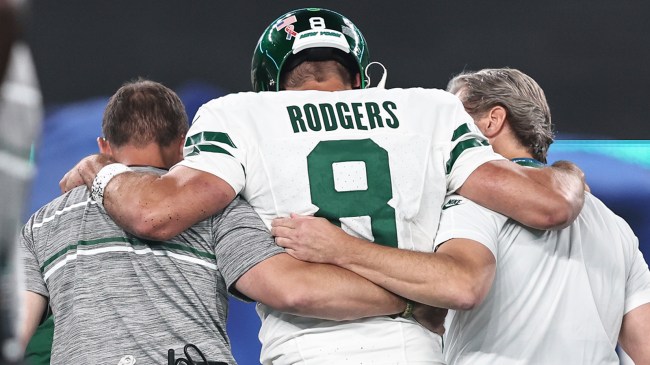
Getty Image
All eyes were on Aaron Rodgers when the Jets faced off against the Bills on Monday Night Football, where millions of fans saw him helped off the field after injuring his Achilles tendon just a few plays into New York’s opening drive. At this point, no one knows what the future holds for the QB, but it’s hard not to fear the worst based on how other people in his position have fared.
I imagine virtually every single person reading this is familiar with the lengthy saga that brought Rodgers to the Jets after spending the first 18 seasons of his career with the Packers, and fans of the franchise that was expecting him to help them turn things around were very optimistic heading into the 2023 campaign.
While New York was able to overcome the setback in the season opener and walk away with the 22-16 victory after Zach Wilson replaced the injured Rodgers, it still feels like the team’s Super Bowl dreams were essentially extinguished just a few minutes into the first quarter in Week 1.
Jets head coach Robert Saleh basically confirmed Rodgers is done for the year in his postgame press conference, and while it seems safe to describe the Achilles injury as “season-ending,” positioning it as a “career-ending” one may also not be a huge stretch when you look at the data.
Studies examining the impact of Achilles injuries are bad news for Aaron Rodgers
There are plenty of notable professional athletes who’ve never been the same after succumbing to an Achilles injury; Kobe Bryant and Patrick Ewing were never able to fully return to form, while Isiah Thomas never played another game after tearing his in 1994.
A couple of years ago, a team of orthopedic experts examined 15 studies that had explored the long-term impact a torn Achilles has had on players in various sports and determined that 24% of the athletes who succumbed to them saw their career end as a result.
In 2019, the Orthopaedic Journal of Sports Medicine published a paper penned by researchers at Brown and Ohio State that specifically focused on NFL players who’ve torn their Achilles. While it had a relatively small sample size of 80 players, the conclusions it drew probably won’t inspire a ton of confidence when it comes to Rodgers’ future.
That study found around 61% of injured players were able to return within 11 months (a number that rises to around 64% when you extend the window to 18 months). However, the data showed that most of those players experienced a significant decline in performance in their first season back and that 15% of the ones who did return eventually tore their Achilles for a second time.
It’s worth noting age didn’t appear to play a significant factor in a player’s ability to recover. However, it essentially states that anyone who injures their Achilles will need at least two years to get back to where they were prior to the setback.
As a result, it’s very, very hard to imagine the 39-year-old Rodgers (a man who seriously considered retiring before asking Green Bay to trade him to the Jets) will have much incentive to attempt to mount a comeback when everything is said and done.
Is there a chance he’ll be able to become a statistical outlier? Sure, but you’re probably not going to want to hold your breath.